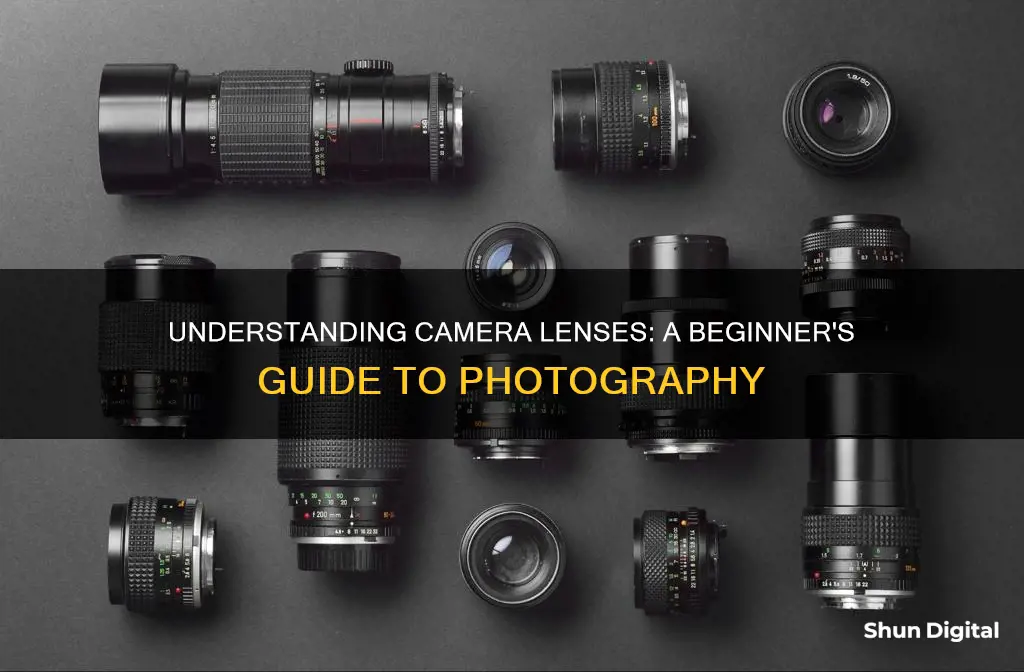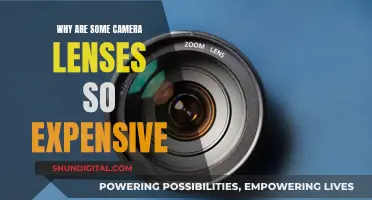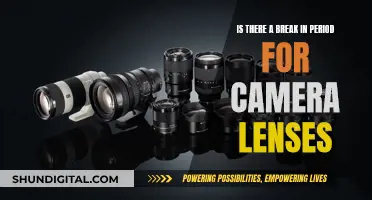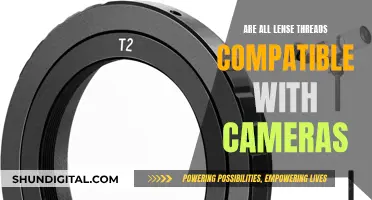
Camera lenses are arguably the most important piece of equipment a photographer can buy – even more important than the camera itself. Lenses are what allow photographers to capture images, by focusing and directing light onto the camera's image sensor or film. The lens is also what controls aspects like framing, perspective, depth of field, and the light entering the camera.
There are two main types of lenses: zoom lenses and prime lenses. Zoom lenses are incredibly versatile and are used for photographing anything from people in the streets to wildlife in the African Savanna. They have variable focal lengths, so with a 70-200mm lens, for example, you can zoom from 70mm all the way up to 200mm. Prime lenses, on the other hand, have a fixed focal range, meaning that you can't zoom in or out. They specialise in just one focal length and generally produce much higher-quality images than zoom lenses.
When it comes to choosing a lens, there are several factors to consider, including focal length, maximum aperture, size and weight, autofocus, durability, ergonomics, and image quality. Focal length refers to how far zoomed in the lens is and is measured in millimetres. Lenses with shorter focal lengths are wide-angle lenses, while those with longer focal lengths are telephoto lenses. Maximum aperture, also known as f-stop, refers to the size of the lens opening when the shutter is open, with smaller numbers like f/2 and f/4 allowing more light to enter the camera.
In addition to these basic specifications, there are several other lens features that can impact your photographs, including distortion, chromatic aberration, bokeh (the quality of a photo's out-of-focus blur), and flare (internal reflections or blobs that appear when pointing the lens at the sun).
Ultimately, the best lens for you will depend on your specific needs and preferences. Whether you're a landscape photographer, a portrait photographer, or a wildlife photographer, understanding the different types of lenses and their features will help you choose the right one for your photography.
| Characteristics | Values |
|---|---|
| Purpose | Capturing images, focusing and directing light onto the camera's image sensor or film |
| Focal length | Determines the field of view. Wide-angle, standard or telephoto |
| Aperture | Controls the amount of light passing through the lens |
| Zoom lenses | Versatile, with variable focal lengths |
| Prime lenses | Classic style, with a fixed focal range |
| Image quality | Sharpness, aberrations, distortion, bokeh |
| Size and weight | Lightweight lenses are more convenient but may have compromised image quality |
| Autofocus | Faster and more accurate autofocus is desirable |
| Durability | Weatherproof lenses are more durable |
| Ergonomics | Smoothness of focus ring, seamless user experience |
What You'll Learn
- Camera lenses are important as they control which photos you can take
- Camera lenses are made up of several components, including the front element, lens hood thread, zoom ring, focus ring, and more
- Camera lenses are categorised into two types: zoom lenses and prime lenses
- Camera lenses have a focal length, which determines the field of view
- Camera lenses have a maximum aperture, which controls the amount of light entering the lens

Camera lenses are important as they control which photos you can take
The lens is the most important part of your photography kit. Without a lens, your camera body could not capture images. A high-quality lens can help you capture great photos even with a cheap camera, while a low-quality lens can make the best camera mediocre.
Lenses are important as they focus and direct light onto the camera's image sensor or film. They let the camera capture images by controlling aspects like framing, perspective, depth of field, and the light entering it. Camera lenses let you manipulate and control the visual aspects of your photographs. They let you influence factors like sharpness, distortion, and other artistic choices for shooting a scene.
The lens's focal length is important because it determines the field of view. This is what makes a lens wide, standard, or telephoto. A short focal length creates a wide field of view, and lenses with a shorter focal length are known as wide-angle lenses. The opposite is also true: a long focal length creates a narrow field of view, and these lenses are known as telephoto lenses.
The lens's maximum aperture is also critical. Aperture describes the "pupil" of your lens. Just like the pupil in our eyes, the aperture in a lens will let in more or less light. Expensive lenses often have large apertures to let in a lot of light.
Lenses with extreme specifications are more likely to have compromises than their relatively ordinary counterparts. Compromises can take many forms, but it usually means lenses with lower image quality or a higher size/weight/price.
In conclusion, camera lenses are important as they control which photos you can take by influencing factors such as focal length, aperture, and image quality.
Cleaning Camera Lenses: A Step-by-Step Guide
You may want to see also

Camera lenses are made up of several components, including the front element, lens hood thread, zoom ring, focus ring, and more
Camera lenses are made up of several components, each serving a unique purpose in capturing images. One of the most crucial components is the front element, which is the foremost piece of glass facing the subject. It plays a vital role in protecting the inner lens elements and bending or refracting incoming light. The front element is also essential in determining the overall performance of the lens assembly.
Another important aspect of camera lenses is the lens hood thread, which is located in front of the first optical lens. This threaded ring allows photographers to easily attach filters and other accessories to the front of the lens. The diameter of this attachment point is measured in millimetres, and it is crucial to consider when shopping for filters, lens caps, and other accessories.
Camera lenses also feature a focusing ring, which is used to adjust the focus manually or through a small motor in automatic cameras. This ring is marked with guide numbers that indicate the distance to the subject and the corresponding f-stops, which represent the range of focusing distances.
For lenses with zoom capabilities, there is a focal length ring that allows photographers to zoom in or out on their subjects. The focal length of a lens is often used to describe its capabilities, such as a 70-300mm lens, indicating its zoom range.
Additionally, the aperture ring controls the aperture within the lens, which is an adjustable opening that regulates the amount of light entering the lens. The aperture size is also measured in f-stops, with larger openings requiring less light and resulting in a shallower depth of field.
These are just some of the key components that make up a camera lens. Each part works in harmony with the others to capture light, focus it onto the image sensor or film, and create the final image.
Full-Frame Lenses: Sharper on Crop Sensor Cameras?
You may want to see also

Camera lenses are categorised into two types: zoom lenses and prime lenses
Camera lenses are essential for photographers, as they are the most important part of a photography kit. The lens is what allows the camera to focus light and capture images. Without a lens, a camera is useless.
Prime lenses, on the other hand, have a fixed focal length, which means that you cannot zoom in or out. The main advantage of prime lenses is that they specialise in just one focal length, so they are finely tuned to deliver on one specific type of photography. Prime lenses generally produce higher-quality images than zoom lenses, but you need to know which situations to use them in. For example, the 50mm prime lens, also known as the "Nifty Fifty", is perfect for portraits as the focal length is similar to the human eye. A 35mm prime lens, on the other hand, is usually used by landscape photographers.
The type of lens you choose will depend on your specific needs and preferences. Zoom lenses offer versatility and convenience, while prime lenses offer higher image quality and specialisation.
The Impact of Constant Lens Usage on Camera Performance
You may want to see also

Camera lenses have a focal length, which determines the field of view
Camera lenses are essential to photography, as they focus light onto the camera's image sensor or film, thus allowing the camera to capture images. The lens is what determines the image's sharpness, distortion, and other artistic choices.
One of the most important characteristics of a camera lens is its focal length, which is the distance between the lens and the plane of the sensor. Focal length is measured in millimetres and is determined when the lens focuses on an object at infinity.
The focal length of a lens is important because it determines the field of view, which is the maximum area of a scene that a camera can capture. In other words, it determines how much of the scene will fit into the frame. A lens with a shorter focal length will have a wider field of view, while a lens with a longer focal length will have a narrower field of view. For example, a wide-angle lens, which typically has a focal length of 35mm or less, will have a wider field of view than a telephoto lens, which has a focal length of 85mm or more.
The field of view can be described by the physical area that can be imaged, such as the horizontal or vertical field of view, or it can be specified in degrees as the angular field of view. The relationship between focal length and field of view is given by the equation:
AFOV = 2 x tan^-1 (H / 2f)
Where AFOV is the angular field of view, H is the sensor size, and f is the focal length.
When choosing a lens, it is important to consider the desired field of view and the type of scene being captured. For example, a wide-angle lens might be a good choice for landscape photography or real estate photography, as it allows more of the scene to be captured in the frame. On the other hand, a telephoto lens might be better suited for wildlife or sports photography, as it allows the photographer to bring distant subjects closer and isolate them from the background.
In addition to the focal length, other factors that can affect the field of view include the working distance (the distance between the lens and the object being captured) and the size of the sensor. By adjusting these factors, photographers can achieve their desired field of view for a particular scene.
Human Eye: The Natural Camera Lens
You may want to see also

Camera lenses have a maximum aperture, which controls the amount of light entering the lens
The aperture is expressed in f-stops, which are fractions. The f-number is not the actual size of the aperture, but it is inversely related to it. This is why f-stops are written as fractions, for example, f/1.4 and f/16. Each increment on the standard f-stop scale halves the amount of light that reaches the sensor.
The aperture of a lens is one of the most important settings in photography. It affects the brightness or exposure of an image. A large aperture (a wide opening) will pass a lot of light, resulting in a brighter photograph. A small aperture does the opposite, making a photo darker.
The aperture also controls the depth of field, which is the amount of the photograph that appears sharp from front to back. A large aperture creates a shallow depth of field, meaning only a small area of the scene is in sharp focus. As the aperture gets smaller, the depth of field grows, so more of the scene is in focus.
The maximum aperture of a lens is included in the name of the lens and is an important specification to consider when choosing a lens. A lens with a large maximum aperture is considered a "fast" lens as it can pass through more light. This makes it ideal for low-light photography.
In summary, the maximum aperture of a camera lens controls the amount of light entering the lens and is a critical setting that affects the brightness and depth of field of an image.
Cleaning Camera Lenses and Filters: A Step-by-Step Guide
You may want to see also
Frequently asked questions
A camera lens is an essential piece of equipment that focuses light onto the camera's sensor or film to create an image. It lets the camera capture images by controlling aspects like framing, perspective, depth of field, and the light entering it.
Camera lenses can be divided into two types: zoom lenses and prime lenses. Zoom lenses offer a range of focal lengths, allowing you to zoom in and out. Prime lenses, on the other hand, have a fixed focal length, meaning you can't zoom.
Focal length refers to how far "zoomed in" the lens is and is measured in millimetres (mm). It determines the field of view, with shorter focal lengths resulting in a wider field of view and longer focal lengths resulting in a narrower field of view. Common focal lengths include wide-angle (16-35mm), normal (35-70mm), and telephoto (70mm and above).
Maximum aperture, denoted by the "f/number", refers to the largest opening of the lens, controlling the amount of light that enters the camera. Lenses with larger maximum apertures (smaller f-numbers) are often more expensive and allow for better low-light performance and shallower depth of field.
Aside from image quality, consider the size and weight of the lens, autofocus performance, durability and weather resistance, ergonomics, and construction quality. Lenses with fewer moving parts and weather sealing tend to be more durable.







